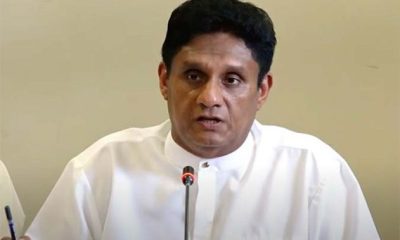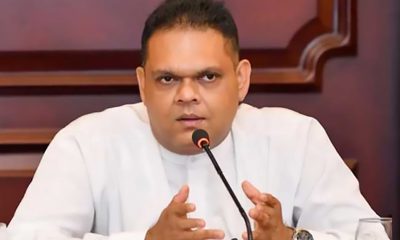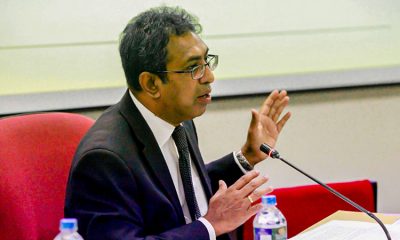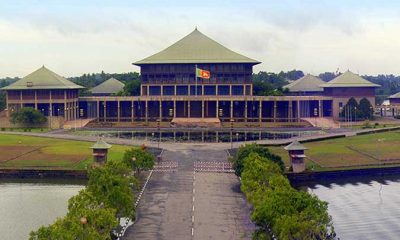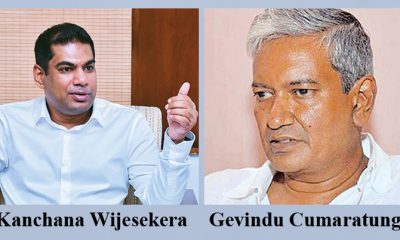Features
Postponing elections: Are there limits to constitutional amendments?

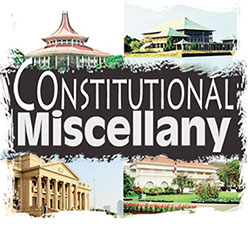 by Dr. Jayampathy Wickramaratne,
by Dr. Jayampathy Wickramaratne,
President’s Counsel
United National Party General Secretary Range Bandara’s statement at a media briefing at UNP Headquarters that the terms of the current President and current Parliament should be extended by two years ‘to save the Nation’ has drawn the ire of the people at large, with even the UNP’s ally (for the moment?), the Sri Lanka Podujana Peramuna distancing itself from the proposal. The essence of the people’s response is that the present Parliament has lost its legitimacy, and President Wickremesinghe has been elected not by the People directly but by that very Parliament for the remainder of the term of President Gotabaya Rajapaksa, who was forced to resign.
An amendment of the Constitution ordinarily requires a two-thirds majority in Parliament. Article 83 provides that a Bill for the amendment or the repeal or replacement of or which is inconsistent with any of the provisions of Articles 1 (The State), 2 (Unitary State), 3 (Sovereignty of the People), 6 (National Flag), 7 (National Anthem), 8 (National Day), 9 (Buddhism), 10 (Freedom of thought, conscience and religion), 11 (Freedom from torture) and Article 83 itself and also a Bill which seeks to extend the term of office of the President or the duration of Parliament to over six years, would become law only if it is passed by a two-thirds majority in Parliament and approved by the People at a referendum.
It has been argued that since the proposal is to extend the terms of the current President and Parliament to seven years, it can only be passed with a two-thirds majority in Parliament and approval at a referendum. It follows from the argument that a referendum would not be needed if the terms are to be extended to six years only.
The writer takes a different view, namely that the terms of an existing Parliament and a President-in-office cannot be extended even with the approval of the People at a referendum as they were elected for a specific term. Such an extension would go against the spirit of the Constitution. As the Lawyers Collective pointed out last week, a two-thirds majority of Parliament and a 50%-plus-One majority of the People cannot just pass ANY amendment.
A seven-member bench of the Supreme Court considered the Fourth Amendment to the Constitution Bill to extend the life of the first Parliament by six years. (Re Fourth Amendment to the Constitution Bill, 1982 (1978–1983) I DSCPB 155.) The Court only stated that as the Cabinet of Ministers had certified that the Bill was intended to be passed by a two-thirds majority and placed before the People at a referendum, it had no jurisdiction in terms of proviso (b) of Article 120. Interestingly, three of the seven judges did not agree with this view, but the reasons for their disagreement were not stated. The names of the dissenting judges, too, were not disclosed, giving rise to various versions in rumour-prone Hulftsdorp.
The Bill was approved by a two-thirds majority in Parliament and at the referendum that followed. The 1982 referendum is the worst blot in Sri Lanka’s election history. Election laws were violated with impunity, and there were many reports that opposition supporters were forced to vote ‘yes’ and show the ballot paper to UNP polling agents. Opposition leaders such as Hector Kobbekaduwa and Pieter Keuneman found out at the polling booth that their votes had already been cast!
At that time, the UNP enjoyed a five-sixths majority in Parliament, obtained through a first-past-the-post electoral system. What followed from the Court’s determination is that the UNP could have postponed Parliamentary elections repeatedly with its super majority as long as 50%-Plus-One of the People approved the same at a referendum.
The Nineteenth Amendment to the Constitution Bill, 2004, a Private Member’s Bill, sought to amend Article 9. The proposed provision read: ‘The official Religion of the Republic is Buddhism. Other forms of religions and worship may be practised in peace and harmony with Buddha Sasana.’ The Supreme Court (Weerasuriya, Thilakawardena and Raja Fernando JJ) held that the clause would curtail the freedom guaranteed to other religions under Articles 10 and 14(1)(e) and would require to be approved at a referendum. (2004–2006) VIII DSCPB 58.
Tilakawardane J, while agreeing with the conclusions of the Court, took an interesting position with regard to constitutional amendments. The learned Judge stated that although Article 75 does not contain any limitations on the power of Parliament regarding constitutional amendments, that power should not be exercised so as to damage or destroy the critical elements of the basic structure of the Constitution. That could only be done with the repeal and replacement of the whole of the Constitution and not through the ‘tinkering’ or amendment of specific Articles of the Constitution. She further stated: ‘An amendment of the two basic features of the Constitution, such as (a) the democratic character of the Constitution and (b) the separation of powers, must perforce be examined in the light of the features in each individual case, in the place of the particular feature in the scheme of the Constitution, it’s objects and purposes and it’s denial on the integrity of the Constitution as the fundamental instrument of the country’s governance.’
Tilakawardane J’s view that certain critical elements of the basic structure should not be ‘tinkered’ with and the identification of the democratic character of the Constitution and separation of powers as two of such features raises a pertinent question:
As long as a two-thirds majority in Parliament passes a constitutional amendment or a new constitution and a majority of the People approves the same, are there no limitations to what can be done? For example, can Sri Lanka be converted to a one-party state if a two-thirds majority in Parliament and a 50%-plus-One majority of the People agree? Similarly, can the freedom from torture not be made available to persons arrested on suspicion of working towards a separate state?
In international law, certain basic norms (jus cogens) are accepted as peremptory norms from which no derogation is permitted. Examples include prohibitions against slavery and torture, genocide, the use of armed force and piracy on the high seas and racial non-discrimination. Similarly, are there basic norms from which a democracy such as Sri Lanka cannot derogate? Can a tyrannous majority adopt any constitution? Would the Supreme Court have the power to examine a Bill for the amendment of the Constitution or a new Constitution, certified by the Cabinet of Ministers as one that requires the People’s approval at a referendum, if certain basic democratic norms are alleged to be violated? Such questions may seem academic at first blush, but given experiences from elsewhere, should they be brushed aside?
When freedom from torture is recognised as a peremptory norm that binds the international community, can the People of Sri Lanka restrict its application within the country, invoking their sovereignty? Put differently, are there no limits to the internal dimension of sovereignty?
The Lawyers Collective also raised the pertinent question of whether the amending process is also governed by the principle of ‘constitutional morality’, a concept which has recently gained wide acceptance in India. Simply put, constitutional morality demands that the spirit of the Constitution be respected and should not be undermined even at the behest of the majority. It is thus a counterpoise to popular or social morality that can sometimes be undemocratic and violative of rights.
In Navtej Singh Johar v. Union of India, the Indian Supreme Court observed as follows: “The concept of constitutional morality is not limited to the mere observance of the core principles of constitutionalism as the magnitude and sweep of constitutional morality is not confined to the provisions and literal text which a Constitution contains, rather it embraces within itself virtues of a wide magnitude such as that of ushering a pluralistic and inclusive society, while at the same time adhering to the other principles of constitutionalism.”
The Court explained that it is further the result of embodying constitutional morality that the values of constitutionalism trickle down and percolate through the apparatus of the State for the betterment of each and every individual citizen of the State. “The society as a whole or even a minuscule part of the society may aspire and prefer different things for themselves.
They are perfectly competent to have such a freedom to be different, like different things, so on and so forth, provided that their different tastes and liking remain within their legal framework and neither violates any statute nor results in the abridgement of fundamental rights of any other citizen. The Preambular goals of our Constitution which contain the noble objectives of Justice, Liberty, Equality and Fraternity can only be achieved through the commitment and loyalty of the organs of the State to the principle of constitutional morality.” (AIR 2018 SC 4321).
The writer submits that peremptory norms that limit the internal dimension of sovereignty are found in the Preamble to our Constitution, which refers to ‘immutable republican principles of representative democracy’ that assure to ‘all peoples freedom, equality, justice, fundamental human rights and the independence of the judiciary as the intangible heritage that guarantees the dignity and well-being of succeeding generations of the People of Sri Lanka’. These, then, are the critical elements of the basic features of our constitutional edifice that defy change.
Features
The heart-friendly health minister

by Dr Gotabhya Ranasinghe
Senior Consultant Cardiologist
National Hospital Sri Lanka
When we sought a meeting with Hon Dr. Ramesh Pathirana, Minister of Health, he graciously cleared his busy schedule to accommodate us. Renowned for his attentive listening and deep understanding, Minister Pathirana is dedicated to advancing the health sector. His openness and transparency exemplify the qualities of an exemplary politician and minister.
Dr. Palitha Mahipala, the current Health Secretary, demonstrates both commendable enthusiasm and unwavering support. This combination of attributes makes him a highly compatible colleague for the esteemed Minister of Health.
Our discussion centered on a project that has been in the works for the past 30 years, one that no other minister had managed to advance.
Minister Pathirana, however, recognized the project’s significance and its potential to revolutionize care for heart patients.
The project involves the construction of a state-of-the-art facility at the premises of the National Hospital Colombo. The project’s location within the premises of the National Hospital underscores its importance and relevance to the healthcare infrastructure of the nation.
This facility will include a cardiology building and a tertiary care center, equipped with the latest technology to handle and treat all types of heart-related conditions and surgeries.
Securing funding was a major milestone for this initiative. Minister Pathirana successfully obtained approval for a $40 billion loan from the Asian Development Bank. With the funding in place, the foundation stone is scheduled to be laid in September this year, and construction will begin in January 2025.
This project guarantees a consistent and uninterrupted supply of stents and related medications for heart patients. As a result, patients will have timely access to essential medical supplies during their treatment and recovery. By securing these critical resources, the project aims to enhance patient outcomes, minimize treatment delays, and maintain the highest standards of cardiac care.
Upon its fruition, this monumental building will serve as a beacon of hope and healing, symbolizing the unwavering dedication to improving patient outcomes and fostering a healthier society.We anticipate a future marked by significant progress and positive outcomes in Sri Lanka’s cardiovascular treatment landscape within the foreseeable timeframe.
Features
A LOVING TRIBUTE TO JESUIT FR. ALOYSIUS PIERIS ON HIS 90th BIRTHDAY

by Fr. Emmanuel Fernando, OMI
Jesuit Fr. Aloysius Pieris (affectionately called Fr. Aloy) celebrated his 90th birthday on April 9, 2024 and I, as the editor of our Oblate Journal, THE MISSIONARY OBLATE had gone to press by that time. Immediately I decided to publish an article, appreciating the untiring selfless services he continues to offer for inter-Faith dialogue, the renewal of the Catholic Church, his concern for the poor and the suffering Sri Lankan masses and to me, the present writer.
It was in 1988, when I was appointed Director of the Oblate Scholastics at Ampitiya by the then Oblate Provincial Fr. Anselm Silva, that I came to know Fr. Aloy more closely. Knowing well his expertise in matters spiritual, theological, Indological and pastoral, and with the collaborative spirit of my companion-formators, our Oblate Scholastics were sent to Tulana, the Research and Encounter Centre, Kelaniya, of which he is the Founder-Director, for ‘exposure-programmes’ on matters spiritual, biblical, theological and pastoral. Some of these dimensions according to my view and that of my companion-formators, were not available at the National Seminary, Ampitiya.
Ever since that time, our Oblate formators/ accompaniers at the Oblate Scholasticate, Ampitiya , have continued to send our Oblate Scholastics to Tulana Centre for deepening their insights and convictions regarding matters needed to serve the people in today’s context. Fr. Aloy also had tried very enthusiastically with the Oblate team headed by Frs. Oswald Firth and Clement Waidyasekara to begin a Theologate, directed by the Religious Congregations in Sri Lanka, for the contextual formation/ accompaniment of their members. It should very well be a desired goal of the Leaders / Provincials of the Religious Congregations.
Besides being a formator/accompanier at the Oblate Scholasticate, I was entrusted also with the task of editing and publishing our Oblate journal, ‘The Missionary Oblate’. To maintain the quality of the journal I continue to depend on Fr. Aloy for his thought-provoking and stimulating articles on Biblical Spirituality, Biblical Theology and Ecclesiology. I am very grateful to him for his generous assistance. Of late, his writings on renewal of the Church, initiated by Pope St. John XX111 and continued by Pope Francis through the Synodal path, published in our Oblate journal, enable our readers to focus their attention also on the needed renewal in the Catholic Church in Sri Lanka. Fr. Aloy appreciated very much the Synodal path adopted by the Jesuit Pope Francis for the renewal of the Church, rooted very much on prayerful discernment. In my Religious and presbyteral life, Fr.Aloy continues to be my spiritual animator / guide and ongoing formator / acccompanier.
Fr. Aloysius Pieris, BA Hons (Lond), LPh (SHC, India), STL (PFT, Naples), PhD (SLU/VC), ThD (Tilburg), D.Ltt (KU), has been one of the eminent Asian theologians well recognized internationally and one who has lectured and held visiting chairs in many universities both in the West and in the East. Many members of Religious Congregations from Asian countries have benefited from his lectures and guidance in the East Asian Pastoral Institute (EAPI) in Manila, Philippines. He had been a Theologian consulted by the Federation of Asian Bishops’ Conferences for many years. During his professorship at the Gregorian University in Rome, he was called to be a member of a special group of advisers on other religions consulted by Pope Paul VI.
Fr. Aloy is the author of more than 30 books and well over 500 Research Papers. Some of his books and articles have been translated and published in several countries. Among those books, one can find the following: 1) The Genesis of an Asian Theology of Liberation (An Autobiographical Excursus on the Art of Theologising in Asia, 2) An Asian Theology of Liberation, 3) Providential Timeliness of Vatican 11 (a long-overdue halt to a scandalous millennium, 4) Give Vatican 11 a chance, 5) Leadership in the Church, 6) Relishing our faith in working for justice (Themes for study and discussion), 7) A Message meant mainly, not exclusively for Jesuits (Background information necessary for helping Francis renew the Church), 8) Lent in Lanka (Reflections and Resolutions, 9) Love meets wisdom (A Christian Experience of Buddhism, 10) Fire and Water 11) God’s Reign for God’s poor, 12) Our Unhiddden Agenda (How we Jesuits work, pray and form our men). He is also the Editor of two journals, Vagdevi, Journal of Religious Reflection and Dialogue, New Series.
Fr. Aloy has a BA in Pali and Sanskrit from the University of London and a Ph.D in Buddhist Philosophy from the University of Sri Lankan, Vidyodaya Campus. On Nov. 23, 2019, he was awarded the prestigious honorary Doctorate of Literature (D.Litt) by the Chancellor of the University of Kelaniya, the Most Venerable Welamitiyawe Dharmakirthi Sri Kusala Dhamma Thera.
Fr. Aloy continues to be a promoter of Gospel values and virtues. Justice as a constitutive dimension of love and social concern for the downtrodden masses are very much noted in his life and work. He had very much appreciated the commitment of the late Fr. Joseph (Joe) Fernando, the National Director of the Social and Economic Centre (SEDEC) for the poor.
In Sri Lanka, a few religious Congregations – the Good Shepherd Sisters, the Christian Brothers, the Marist Brothers and the Oblates – have invited him to animate their members especially during their Provincial Congresses, Chapters and International Conferences. The mainline Christian Churches also have sought his advice and followed his seminars. I, for one, regret very much, that the Sri Lankan authorities of the Catholic Church –today’s Hierarchy—- have not sought Fr.
Aloy’s expertise for the renewal of the Catholic Church in Sri Lanka and thus have not benefited from the immense store of wisdom and insight that he can offer to our local Church while the Sri Lankan bishops who governed the Catholic church in the immediate aftermath of the Second Vatican Council (Edmund Fernando OMI, Anthony de Saram, Leo Nanayakkara OSB, Frank Marcus Fernando, Paul Perera,) visited him and consulted him on many matters. Among the Tamil Bishops, Bishop Rayappu Joseph was keeping close contact with him and Bishop J. Deogupillai hosted him and his team visiting him after the horrible Black July massacre of Tamils.
Features
A fairy tale, success or debacle

Sri Lanka-Singapore Free Trade Agreement
By Gomi Senadhira
senadhiragomi@gmail.com
“You might tell fairy tales, but the progress of a country cannot be achieved through such narratives. A country cannot be developed by making false promises. The country moved backward because of the electoral promises made by political parties throughout time. We have witnessed that the ultimate result of this is the country becoming bankrupt. Unfortunately, many segments of the population have not come to realize this yet.” – President Ranil Wickremesinghe, 2024 Budget speech
Any Sri Lankan would agree with the above words of President Wickremesinghe on the false promises our politicians and officials make and the fairy tales they narrate which bankrupted this country. So, to understand this, let’s look at one such fairy tale with lots of false promises; Ranil Wickremesinghe’s greatest achievement in the area of international trade and investment promotion during the Yahapalana period, Sri Lanka-Singapore Free Trade Agreement (SLSFTA).
It is appropriate and timely to do it now as Finance Minister Wickremesinghe has just presented to parliament a bill on the National Policy on Economic Transformation which includes the establishment of an Office for International Trade and the Sri Lanka Institute of Economics and International Trade.
Was SLSFTA a “Cleverly negotiated Free Trade Agreement” as stated by the (former) Minister of Development Strategies and International Trade Malik Samarawickrama during the Parliamentary Debate on the SLSFTA in July 2018, or a colossal blunder covered up with lies, false promises, and fairy tales? After SLSFTA was signed there were a number of fairy tales published on this agreement by the Ministry of Development Strategies and International, Institute of Policy Studies, and others.
However, for this article, I would like to limit my comments to the speech by Minister Samarawickrama during the Parliamentary Debate, and the two most important areas in the agreement which were covered up with lies, fairy tales, and false promises, namely: revenue loss for Sri Lanka and Investment from Singapore. On the other important area, “Waste products dumping” I do not want to comment here as I have written extensively on the issue.
1. The revenue loss
During the Parliamentary Debate in July 2018, Minister Samarawickrama stated “…. let me reiterate that this FTA with Singapore has been very cleverly negotiated by us…. The liberalisation programme under this FTA has been carefully designed to have the least impact on domestic industry and revenue collection. We have included all revenue sensitive items in the negative list of items which will not be subject to removal of tariff. Therefore, 97.8% revenue from Customs duty is protected. Our tariff liberalisation will take place over a period of 12-15 years! In fact, the revenue earned through tariffs on goods imported from Singapore last year was Rs. 35 billion.
The revenue loss for over the next 15 years due to the FTA is only Rs. 733 million– which when annualised, on average, is just Rs. 51 million. That is just 0.14% per year! So anyone who claims the Singapore FTA causes revenue loss to the Government cannot do basic arithmetic! Mr. Speaker, in conclusion, I call on my fellow members of this House – don’t mislead the public with baseless criticism that is not grounded in facts. Don’t look at petty politics and use these issues for your own political survival.”
I was surprised to read the minister’s speech because an article published in January 2018 in “The Straits Times“, based on information released by the Singaporean Negotiators stated, “…. With the FTA, tariff savings for Singapore exports are estimated to hit $10 million annually“.
As the annual tariff savings (that is the revenue loss for Sri Lanka) calculated by the Singaporean Negotiators, Singaporean $ 10 million (Sri Lankan rupees 1,200 million in 2018) was way above the rupees’ 733 million revenue loss for 15 years estimated by the Sri Lankan negotiators, it was clear to any observer that one of the parties to the agreement had not done the basic arithmetic!
Six years later, according to a report published by “The Morning” newspaper, speaking at the Committee on Public Finance (COPF) on 7th May 2024, Mr Samarawickrama’s chief trade negotiator K.J. Weerasinghehad had admitted “…. that forecasted revenue loss for the Government of Sri Lanka through the Singapore FTA is Rs. 450 million in 2023 and Rs. 1.3 billion in 2024.”
If these numbers are correct, as tariff liberalisation under the SLSFTA has just started, we will pass Rs 2 billion very soon. Then, the question is how Sri Lanka’s trade negotiators made such a colossal blunder. Didn’t they do their basic arithmetic? If they didn’t know how to do basic arithmetic they should have at least done their basic readings. For example, the headline of the article published in The Straits Times in January 2018 was “Singapore, Sri Lanka sign FTA, annual savings of $10m expected”.
Anyway, as Sri Lanka’s chief negotiator reiterated at the COPF meeting that “…. since 99% of the tariffs in Singapore have zero rates of duty, Sri Lanka has agreed on 80% tariff liberalisation over a period of 15 years while expecting Singapore investments to address the imbalance in trade,” let’s turn towards investment.
Investment from Singapore
In July 2018, speaking during the Parliamentary Debate on the FTA this is what Minister Malik Samarawickrama stated on investment from Singapore, “Already, thanks to this FTA, in just the past two-and-a-half months since the agreement came into effect we have received a proposal from Singapore for investment amounting to $ 14.8 billion in an oil refinery for export of petroleum products. In addition, we have proposals for a steel manufacturing plant for exports ($ 1 billion investment), flour milling plant ($ 50 million), sugar refinery ($ 200 million). This adds up to more than $ 16.05 billion in the pipeline on these projects alone.
And all of these projects will create thousands of more jobs for our people. In principle approval has already been granted by the BOI and the investors are awaiting the release of land the environmental approvals to commence the project.
I request the Opposition and those with vested interests to change their narrow-minded thinking and join us to develop our country. We must always look at what is best for the whole community, not just the few who may oppose. We owe it to our people to courageously take decisions that will change their lives for the better.”
According to the media report I quoted earlier, speaking at the Committee on Public Finance (COPF) Chief Negotiator Weerasinghe has admitted that Sri Lanka was not happy with overall Singapore investments that have come in the past few years in return for the trade liberalisation under the Singapore-Sri Lanka Free Trade Agreement. He has added that between 2021 and 2023 the total investment from Singapore had been around $162 million!
What happened to those projects worth $16 billion negotiated, thanks to the SLSFTA, in just the two-and-a-half months after the agreement came into effect and approved by the BOI? I do not know about the steel manufacturing plant for exports ($ 1 billion investment), flour milling plant ($ 50 million) and sugar refinery ($ 200 million).
However, story of the multibillion-dollar investment in the Petroleum Refinery unfolded in a manner that would qualify it as the best fairy tale with false promises presented by our politicians and the officials, prior to 2019 elections.
Though many Sri Lankans got to know, through the media which repeatedly highlighted a plethora of issues surrounding the project and the questionable credentials of the Singaporean investor, the construction work on the Mirrijiwela Oil Refinery along with the cement factory began on the24th of March 2019 with a bang and Minister Ranil Wickremesinghe and his ministers along with the foreign and local dignitaries laid the foundation stones.
That was few months before the 2019 Presidential elections. Inaugurating the construction work Prime Minister Ranil Wickremesinghe said the projects will create thousands of job opportunities in the area and surrounding districts.
The oil refinery, which was to be built over 200 acres of land, with the capacity to refine 200,000 barrels of crude oil per day, was to generate US$7 billion of exports and create 1,500 direct and 3,000 indirect jobs. The construction of the refinery was to be completed in 44 months. Four years later, in August 2023 the Cabinet of Ministers approved the proposal presented by President Ranil Wickremesinghe to cancel the agreement with the investors of the refinery as the project has not been implemented! Can they explain to the country how much money was wasted to produce that fairy tale?
It is obvious that the President, ministers, and officials had made huge blunders and had deliberately misled the public and the parliament on the revenue loss and potential investment from SLSFTA with fairy tales and false promises.
As the president himself said, a country cannot be developed by making false promises or with fairy tales and these false promises and fairy tales had bankrupted the country. “Unfortunately, many segments of the population have not come to realize this yet”.
(The writer, a specialist and an activist on trade and development issues . )


